Review: Red macroalgae in the genomic era
 I highly recommend this excellent and accessible article by Borg et al. that provides an overview of the red macroalgae, which “may have been the first eukaryotic lineage to have evolved complex multicellularity”. It’s full of fascinating information: although 97% of red algal species are marine, one lives in sloth hairs, and nori (sushi seaweed) is made from red algae (Porphyra and Pyropia genera). This article also gives an excellent and fascinating overview of red algal cell biology; from their unique cell wall polysaccharides that provide them with strength and elasticity (and us with agarose) to their unusual and highly efficient light-harvesting antennae (phycobilisomes) and their lack of plasmodesmata. There’s a tremendous diversity and variation in the reproductive biology of the red algae spanning from triphasic life cycles to the presence of trichogynes that receive the male nucleus for fertilization; interestingly, the authors point out that this great diversity offers the opportunity to explore questions about the evolutionary and ecological importance of sex. As the title suggests, genomic tools and the emergence of some model species are now shedding further light on these fascinating and important organisms. Summary by Mary Williams @PlantTeaching) New Phytol. https://doi.org/10.1111/nph.19211
I highly recommend this excellent and accessible article by Borg et al. that provides an overview of the red macroalgae, which “may have been the first eukaryotic lineage to have evolved complex multicellularity”. It’s full of fascinating information: although 97% of red algal species are marine, one lives in sloth hairs, and nori (sushi seaweed) is made from red algae (Porphyra and Pyropia genera). This article also gives an excellent and fascinating overview of red algal cell biology; from their unique cell wall polysaccharides that provide them with strength and elasticity (and us with agarose) to their unusual and highly efficient light-harvesting antennae (phycobilisomes) and their lack of plasmodesmata. There’s a tremendous diversity and variation in the reproductive biology of the red algae spanning from triphasic life cycles to the presence of trichogynes that receive the male nucleus for fertilization; interestingly, the authors point out that this great diversity offers the opportunity to explore questions about the evolutionary and ecological importance of sex. As the title suggests, genomic tools and the emergence of some model species are now shedding further light on these fascinating and important organisms. Summary by Mary Williams @PlantTeaching) New Phytol. https://doi.org/10.1111/nph.19211
Review: How plant roots respond to waterlogging
As the hottest year on record, 2023 has truly been a global annus horribilis during which 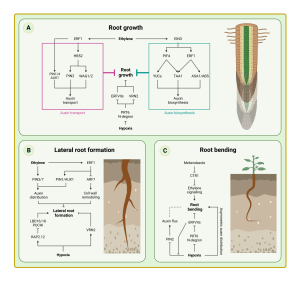 humans, other animals, and domesticated and wild plants have faced unprecedented environmental challenges. In the past month alone, torrential rainfalls have wreaked havoc in Asia, the Middle East, and many parts of Africa, Europe, and the Americas. Frightenedly, disruptive flooding is expected to get worse, adding to food security concerns. Therefore, it’s timely to read about how plants respond to waterlogging in the new review by Daniel and Hartman. The main challenge in waterlogging is hypoxia, oxygen deprivation. The plant senses its waterlogged state through both hypoxia and an accumulation of ethylene, which is not able to diffuse away under water. Some plants have adaptations that enable them to tolerate at least some waterlogging, such as aerenchyma (air channels in roots), the ability to enter a quiescent state, or rapid elongation to reach above the water level. However, for non-adapted plants, even short periods can be lethal. The review covers plant responses from sensing, metabolic changes, and growth responses including changes to root system architecture and gravitropic setpoints (plants are amazing). It also discusses the very important question of translating from simple experimental systems (e.g., Arabidopsis on Petri plates) to real-world conditions, and makes the plea for moving towards “less artificial” experimental conditions. (Summary by Mary Williams @PlantTeaching) J. Exp. Bot. 10.1093/jxb/erad332
humans, other animals, and domesticated and wild plants have faced unprecedented environmental challenges. In the past month alone, torrential rainfalls have wreaked havoc in Asia, the Middle East, and many parts of Africa, Europe, and the Americas. Frightenedly, disruptive flooding is expected to get worse, adding to food security concerns. Therefore, it’s timely to read about how plants respond to waterlogging in the new review by Daniel and Hartman. The main challenge in waterlogging is hypoxia, oxygen deprivation. The plant senses its waterlogged state through both hypoxia and an accumulation of ethylene, which is not able to diffuse away under water. Some plants have adaptations that enable them to tolerate at least some waterlogging, such as aerenchyma (air channels in roots), the ability to enter a quiescent state, or rapid elongation to reach above the water level. However, for non-adapted plants, even short periods can be lethal. The review covers plant responses from sensing, metabolic changes, and growth responses including changes to root system architecture and gravitropic setpoints (plants are amazing). It also discusses the very important question of translating from simple experimental systems (e.g., Arabidopsis on Petri plates) to real-world conditions, and makes the plea for moving towards “less artificial” experimental conditions. (Summary by Mary Williams @PlantTeaching) J. Exp. Bot. 10.1093/jxb/erad332
Plant Physiology Focus Issue: Plant Cell Polarity
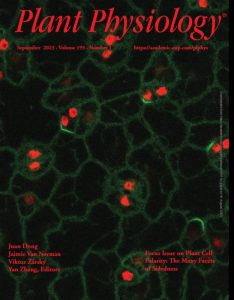 The September issue of Plant Physiology has a focus on plant cell polarity, which plays a pivotal role in the fundamental processes that dictate plant growth, development, and adaptation. By establishing distinct regions within cells, plant cell polarity is crucial for regulating asymmetric cell divisions, guiding the direction of cell expansion, and determining the spatial distribution of essential cellular components. Understanding the mechanisms and regulatory pathways involved in plant cell polarity holds immense promise for enhancing crop productivity, optimizing plant responses to changing environments, and ultimately contributing to sustainable agriculture and ecological resilience. Don’t miss the editorial overview by Dong et al., and keep your eyes open for the registration link for a Focus Issue webinar to be held Sept. 25. (Summary by Mary Williams @PlantTeaching) Plant Physiol. 10.1093/plphys/kiad436.
The September issue of Plant Physiology has a focus on plant cell polarity, which plays a pivotal role in the fundamental processes that dictate plant growth, development, and adaptation. By establishing distinct regions within cells, plant cell polarity is crucial for regulating asymmetric cell divisions, guiding the direction of cell expansion, and determining the spatial distribution of essential cellular components. Understanding the mechanisms and regulatory pathways involved in plant cell polarity holds immense promise for enhancing crop productivity, optimizing plant responses to changing environments, and ultimately contributing to sustainable agriculture and ecological resilience. Don’t miss the editorial overview by Dong et al., and keep your eyes open for the registration link for a Focus Issue webinar to be held Sept. 25. (Summary by Mary Williams @PlantTeaching) Plant Physiol. 10.1093/plphys/kiad436.
The Plant Cell Focus Issue: Biomolecular Condensates
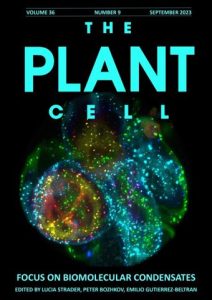 The September issue of The Plant Cell includes a focus on biomolecular condensates. Although the term “biomolecular condensates” is relatively new, it actually reflects a convergence and synthesis of several distinct threads of research. Biomolecular condensates span from “classic” membraneless organelles (e.g., nucleolus, pyrenoid) to small, transient functional condensates, some of which are only recently recognized. A lot of the advancements in our understanding come from new tools and imaging techniques that reveal condensate structures and functions, many of which are reviewed here. The collection provides a great overview of this coalescing discipline. Start with the editorial overview by Gutierrez-Beltran et al. (Summary by Mary Williams @PlantTeaching) Plant Cell 10.1093/plcell/koad182 Furthermore, there’s a not-to-miss webinar on September 13 featuring three authors whose work appears in the Focus Issue; register at https://plantae.org/plant-cell-webinar-biomolecular-condensates/.
The September issue of The Plant Cell includes a focus on biomolecular condensates. Although the term “biomolecular condensates” is relatively new, it actually reflects a convergence and synthesis of several distinct threads of research. Biomolecular condensates span from “classic” membraneless organelles (e.g., nucleolus, pyrenoid) to small, transient functional condensates, some of which are only recently recognized. A lot of the advancements in our understanding come from new tools and imaging techniques that reveal condensate structures and functions, many of which are reviewed here. The collection provides a great overview of this coalescing discipline. Start with the editorial overview by Gutierrez-Beltran et al. (Summary by Mary Williams @PlantTeaching) Plant Cell 10.1093/plcell/koad182 Furthermore, there’s a not-to-miss webinar on September 13 featuring three authors whose work appears in the Focus Issue; register at https://plantae.org/plant-cell-webinar-biomolecular-condensates/.
Immature leaves are the dominant volatile-sensing organs of maize
 It’s well established that damaged plant tissues emit volatile compounds that bolster defense responses in nearby plants, but how those neighbors sense these compounds has remained obscure. This new work by Wang et al. reveals some important clues. First, as the title indicates, immature leaves are much more responsive to damage-associated volatiles (the authors specifically use (Z)-3-hexenyl acetate, HAC, as a proxy in many of their studies). This is a volatile-specific developmental effect; older leaves remain sensitive and responsive to non-volatile defense cues such as the peptide ZmPep3. The authors also investigated factors that might affect volatile perception, looking at both stomatal aperture and the epidermal cuticle as possible variables. Interestingly, changing neither appears to affect volatile perception. The authors speculate that factors involved in HAC perception or early stages of the signal transduction pathway might be preferentially expressed in young leaves, and suggest that, as young leaves are present at the outer periphery, the plant might benefit from focusing its perception in these regions (an analogy is drawn to the heightened environmental sensitivity of the root tip). Or, the plant might preferentially protect its young leaves by providing them with heightened sensitivity. Finally, the authors observe that knowing about this developmental pattern of sensitivity can provide an opportunity to finally identify the specific receptors for these volatiles. (Summary by Mary Williams @PlantTeaching) Curr. Biol. 10.1016/j.cub.2023.07.045
It’s well established that damaged plant tissues emit volatile compounds that bolster defense responses in nearby plants, but how those neighbors sense these compounds has remained obscure. This new work by Wang et al. reveals some important clues. First, as the title indicates, immature leaves are much more responsive to damage-associated volatiles (the authors specifically use (Z)-3-hexenyl acetate, HAC, as a proxy in many of their studies). This is a volatile-specific developmental effect; older leaves remain sensitive and responsive to non-volatile defense cues such as the peptide ZmPep3. The authors also investigated factors that might affect volatile perception, looking at both stomatal aperture and the epidermal cuticle as possible variables. Interestingly, changing neither appears to affect volatile perception. The authors speculate that factors involved in HAC perception or early stages of the signal transduction pathway might be preferentially expressed in young leaves, and suggest that, as young leaves are present at the outer periphery, the plant might benefit from focusing its perception in these regions (an analogy is drawn to the heightened environmental sensitivity of the root tip). Or, the plant might preferentially protect its young leaves by providing them with heightened sensitivity. Finally, the authors observe that knowing about this developmental pattern of sensitivity can provide an opportunity to finally identify the specific receptors for these volatiles. (Summary by Mary Williams @PlantTeaching) Curr. Biol. 10.1016/j.cub.2023.07.045
Genome sequencing reveals the genetic architecture of heterostyly and domestication history of common buckwheat
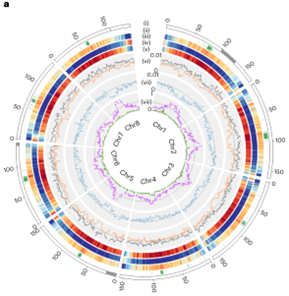 Common buckwheat (Fagopyrum esculentum) is a self-incompatible orphan crop which is gaining interest as it can be grown worldwide and grows well in low fertility soil. However, there are limited genomic resources available for common buckwheat. Here Fawcett et al. combined Illumnia short-read data with PacBio HiFi long-read data to produce a 1.27 Gb chromosome-level assembly of common buckwheat with over 30,000 annotated gene models. Surprisingly, 76% (960 Mb) of the genome was transposable elements, with the majority being Gypsy-type retrotransposons. Fluorescence in situ hybridization showed many Gypsy– retrotransposons at the centromeres, likely to have evolved after common buckwheat diverged from the closely related orphan crop tartary buckwheat (F. tataricum). The reference genome revealed many other interesting loci. The authors highlight a hemizygous gene S-ELF which is involved in heterostyly, a phenomenon where common buckwheat has two flower morphs each of which is self-incompatible, so both are required for reproduction. Knocking out S-ELF led to self-compatible flowers, suggesting a role for S-ELF in female compatibility and determining style length. The authors also used their reference genome to identify two endosperm-expressed copies of the starch synthesis gene Granule-Bound Starch Synthase (GBSS), most likely generated due to whole genome duplication during common buckwheat evolution. EMS-mutagenesis was used to knock out both GBSS paralogs and the double homozygous mutant had a waxy phenotype, which is the first example of waxy common buckwheat. These knockout gbss alleles are currently being introduced into elite common buckwheat varieties, demonstrating how the reference genome produced here can aid breeding. (Summary by Rose McNully @Rose_McN) Nature Plants 10.1038/s41477-023-01474-1
Common buckwheat (Fagopyrum esculentum) is a self-incompatible orphan crop which is gaining interest as it can be grown worldwide and grows well in low fertility soil. However, there are limited genomic resources available for common buckwheat. Here Fawcett et al. combined Illumnia short-read data with PacBio HiFi long-read data to produce a 1.27 Gb chromosome-level assembly of common buckwheat with over 30,000 annotated gene models. Surprisingly, 76% (960 Mb) of the genome was transposable elements, with the majority being Gypsy-type retrotransposons. Fluorescence in situ hybridization showed many Gypsy– retrotransposons at the centromeres, likely to have evolved after common buckwheat diverged from the closely related orphan crop tartary buckwheat (F. tataricum). The reference genome revealed many other interesting loci. The authors highlight a hemizygous gene S-ELF which is involved in heterostyly, a phenomenon where common buckwheat has two flower morphs each of which is self-incompatible, so both are required for reproduction. Knocking out S-ELF led to self-compatible flowers, suggesting a role for S-ELF in female compatibility and determining style length. The authors also used their reference genome to identify two endosperm-expressed copies of the starch synthesis gene Granule-Bound Starch Synthase (GBSS), most likely generated due to whole genome duplication during common buckwheat evolution. EMS-mutagenesis was used to knock out both GBSS paralogs and the double homozygous mutant had a waxy phenotype, which is the first example of waxy common buckwheat. These knockout gbss alleles are currently being introduced into elite common buckwheat varieties, demonstrating how the reference genome produced here can aid breeding. (Summary by Rose McNully @Rose_McN) Nature Plants 10.1038/s41477-023-01474-1
Water fluxes contribute to growth patterning in shoot meristems
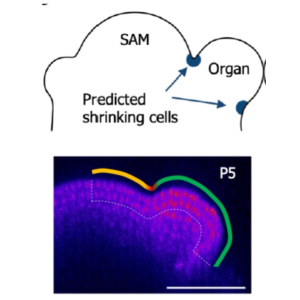 The shoot apical meristem (SAM) is a wonderous thing. How this tiny clump of cells generates the entire above-ground organ system regularly, predictably, and dynamically is a question that has been investigated for decades, with models incorporating cascades regulatory genes, diffusible peptides, hormone fluxes, cell wall properties, cytoskeletal patterns, and more. In this new preprint by Alonso-Serra et al., water fluxes are introduced as contributors to growth patterning. The authors used timelapse imaging to create a 3D cell volume map of the growing meristem, followed by imaging of a fluorescent dye that mimics water movement. They found that cells in the boundary layer (the fold between the meristem and the emerging primordium) actually shrink in the absence of cell division, while adjacent cells expand, consistent with water movement between cells. Their model predicts that the rapid expansion of the growing cells leads to a decrease in their hydrostatic pressure, creating a sink that draws water from neighboring cells. As the authors conclude, these findings “make water a patterning factor at the shoot apex acting in synergy with mechanical and biochemical cues.” (Summary by Mary Williams @PlantTeaching) bioRiv 10.1101/2023.08.27.554993
The shoot apical meristem (SAM) is a wonderous thing. How this tiny clump of cells generates the entire above-ground organ system regularly, predictably, and dynamically is a question that has been investigated for decades, with models incorporating cascades regulatory genes, diffusible peptides, hormone fluxes, cell wall properties, cytoskeletal patterns, and more. In this new preprint by Alonso-Serra et al., water fluxes are introduced as contributors to growth patterning. The authors used timelapse imaging to create a 3D cell volume map of the growing meristem, followed by imaging of a fluorescent dye that mimics water movement. They found that cells in the boundary layer (the fold between the meristem and the emerging primordium) actually shrink in the absence of cell division, while adjacent cells expand, consistent with water movement between cells. Their model predicts that the rapid expansion of the growing cells leads to a decrease in their hydrostatic pressure, creating a sink that draws water from neighboring cells. As the authors conclude, these findings “make water a patterning factor at the shoot apex acting in synergy with mechanical and biochemical cues.” (Summary by Mary Williams @PlantTeaching) bioRiv 10.1101/2023.08.27.554993
LysM-mediated signaling in Marchantia polymorpha highlights the conservation of pattern-triggered immunity in land plants
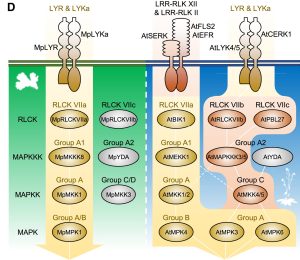 Marchantia polymorpha, the common (but adorable) liverwort, has earned its spot in the ranks of very important plant model systems, joining Physcomitrium patens as representatives of the bryophyte clade. Many systems first characterized in Arabidopsis and other angiosperms are now being studied in these plants, providing much-needed insights into their evolutionary origins and trajectories. Here, Yotsui and colleagues show evidence for functional LysM (Lysin-motif) receptors in M. polymorpha. LysM receptors recognize peptidoglycans and chitins, cell wall components of bacteria and fungi, and can recognize both pathogens and symbiotic organisms. Previous studies showed that M. polymorpha recognized bacterial and fungal cell wall extracts; this new work demonstrates that it does this through LysM receptors. Furthermore, disruption mutants of some LysM-encoding genes showed decreased responses to chitin and peptidoglycans. The authors also identified signaling components downstream of LysM through phosphoproteomic approaches. Interestingly, the found that the blue-light receptor phototropin appears to be a negative regulator of LysM-mediated defenses. (Summary by Mary Williams @PlantTeaching) Curr. Biol. 10.1016/j.cub.2023.07.068
Marchantia polymorpha, the common (but adorable) liverwort, has earned its spot in the ranks of very important plant model systems, joining Physcomitrium patens as representatives of the bryophyte clade. Many systems first characterized in Arabidopsis and other angiosperms are now being studied in these plants, providing much-needed insights into their evolutionary origins and trajectories. Here, Yotsui and colleagues show evidence for functional LysM (Lysin-motif) receptors in M. polymorpha. LysM receptors recognize peptidoglycans and chitins, cell wall components of bacteria and fungi, and can recognize both pathogens and symbiotic organisms. Previous studies showed that M. polymorpha recognized bacterial and fungal cell wall extracts; this new work demonstrates that it does this through LysM receptors. Furthermore, disruption mutants of some LysM-encoding genes showed decreased responses to chitin and peptidoglycans. The authors also identified signaling components downstream of LysM through phosphoproteomic approaches. Interestingly, the found that the blue-light receptor phototropin appears to be a negative regulator of LysM-mediated defenses. (Summary by Mary Williams @PlantTeaching) Curr. Biol. 10.1016/j.cub.2023.07.068
 The September issue of The Plant Cell includes a focus on biomolecular condensates. Although the term “biomolecular condensates” is relatively new, it actually reflects a convergence and synthesis of several distinct threads of research. Biomolecular condensates span from “classic” membraneless organelles (e.g., nucleolus, pyrenoid) to small, transient functional condensates, some of which are only recently recognized. A lot of the advancements in our understanding come from new tools and imaging techniques that reveal condensate structures and functions, many of which are reviewed here. The collection provides a great overview of this coalescing discipline. Start with the editorial overview by Gutierrez-Beltran et al. (Summary by Mary Williams @PlantTeaching) Plant Cell 10.1093/plcell/koad182 Furthermore, there’s a not-to-miss webinar on September 13 featuring three authors whose work appears in the Focus Issue; register at https://plantae.org/plant-cell-webinar-biomolecular-condensates/.
The September issue of The Plant Cell includes a focus on biomolecular condensates. Although the term “biomolecular condensates” is relatively new, it actually reflects a convergence and synthesis of several distinct threads of research. Biomolecular condensates span from “classic” membraneless organelles (e.g., nucleolus, pyrenoid) to small, transient functional condensates, some of which are only recently recognized. A lot of the advancements in our understanding come from new tools and imaging techniques that reveal condensate structures and functions, many of which are reviewed here. The collection provides a great overview of this coalescing discipline. Start with the editorial overview by Gutierrez-Beltran et al. (Summary by Mary Williams @PlantTeaching) Plant Cell 10.1093/plcell/koad182 Furthermore, there’s a not-to-miss webinar on September 13 featuring three authors whose work appears in the Focus Issue; register at https://plantae.org/plant-cell-webinar-biomolecular-condensates/.








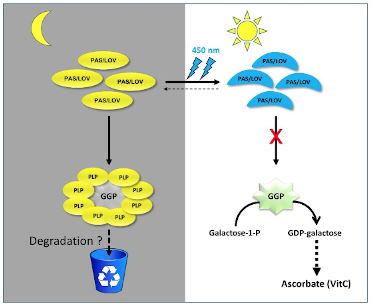 Findings: Our work uncovers the mechanism by which plants use blue light to modulate ascorbate biosynthesis. From a tomato mutant, we identified a photoreceptor named PAS/LOV (PLP) and revealed that it functions as a negative regulator in vivo and in vitro by interacting with the GDP-galactose phosphorylase (GGP), which is known to be the most controlling enzyme of the pathway. We also demonstrated that blue light counteracts the inhibition of the GDP-galactose phosphorylase by the PAS/LOV photoreceptor. This is a major finding because it finally explains how plants protect themselves from too much light by synthesizing more of their main antioxidant.
Findings: Our work uncovers the mechanism by which plants use blue light to modulate ascorbate biosynthesis. From a tomato mutant, we identified a photoreceptor named PAS/LOV (PLP) and revealed that it functions as a negative regulator in vivo and in vitro by interacting with the GDP-galactose phosphorylase (GGP), which is known to be the most controlling enzyme of the pathway. We also demonstrated that blue light counteracts the inhibition of the GDP-galactose phosphorylase by the PAS/LOV photoreceptor. This is a major finding because it finally explains how plants protect themselves from too much light by synthesizing more of their main antioxidant.